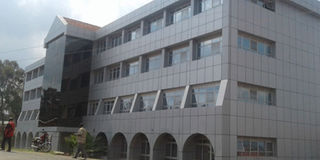Government puts cap on creating new administrative units

Infrastructure. A man walks past Rukungiri District local government administration block. Government has put a cap on the creation of new administrative units around the country, citing budget constraints. PHOTO BY EDSON KINENE
Government has put a cap on the creation of new administrative units around the country citing budget constraints.
“As you are aware, government has created more than 364 sub-counties, 352 town councils and 10 cities have been approved. However, resources have not yet been secured for operationalisation of these newly created units.” Mr Matia Kasaija, the minister of Finance, Planning and Economic Development, said on Thursday.
The minister’s speech was read by Mr John Muhirwoha, the commissioner for district administration in the Ministry of Finance, at the local government regional budget consultative workshop for Financial Year 2020/2021 in Fort Portal Town, Kabarole District.
“To address this matter comprehensively, government has taken a decision that in future, creation of any new administrative units in government must have a certificate of financial implications to certify that government has the resources to finance these institutions,” the minister’s statement added.
Uganda is divided into 134 districts with administrative structures that include, among others, a Chief Administrative Officer and a Resident District Commissioner.
The minister also said that there were variances in the appropriated budget for 2019/2020 Financial Year, which have affected the budget.
“You will note that there were a number of anomalies at the appropriation of the budget for Financial Year 2019/2020. This arose because some Local Government projections were not appropriately captured at the time of appropriation and as such, some received higher allocations than their projected levels, while others received less than what they had projected,” Mr Kasaija said.
The minister also said there is delayed payment of salaries, pension, gratuity and service providers in various administrative units.
“I have received numerous complaints from service providers on delayed payments/non-payments to service providers,” Mr Kasaija said, adding that government has introduced the E-cash System to curtail the problem.
The government created new administrative units with a view of bringing services closer to the people but most of them are financially crippled with staff challenges.
Last year, Mr Kasaija warned that the creation of new administrative units without proper planning would jeopardise government progress.
Impact in Ntoroko
The Chief Administrative Officer of Ntoroko District, Mr Anselm Kyaligonza, said with the current staff ceiling challenge, they are operating at 29 per cent of staff recruitment, hampering service delivery.
Responding to this, Mr Muhirwoha said the ministry is targeting 65 per cent of staff recruitment in all districts in the next three years.
Many government-aided schools in Ntoroko are facing acute shortage of teachers.
The Ntoroko senior education officer, Ms Moreen Kusemererwa, early this year observed that due to the shortage of staff, many schools have in the last three years failed to complete the syllabus.
Statistics from the district education department indicate that the district has a staff ceiling of 108 secondary school teachers but only 52 are available, leaving a deficit of 58.
For primary schools, the staff ceiling is 335 but 300 are available, leaving a deficit of 35 teachers.
The senior education officer blames the failure to recruit teachers on the shoestring budget from the central government.
“The teacher-pupil ratio is beyond the government policy of one teacher to 53 pupils and this is affecting students’ performance,” Ms Kusemererwa told Daily Monitor in April.
The district chairperson, Mr Timothy Kyamanywa, said for the last three years, they have been able to recruit only 29 teachers who have not received salary since their appointment.




